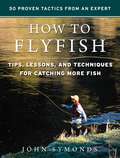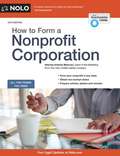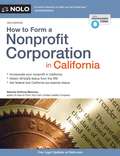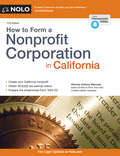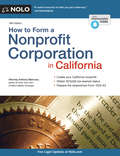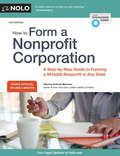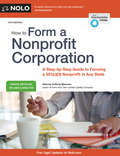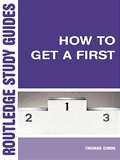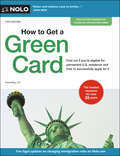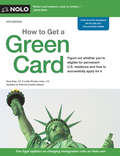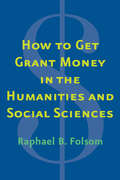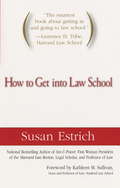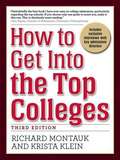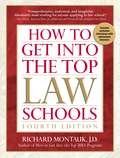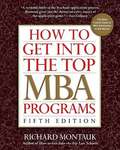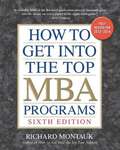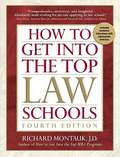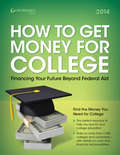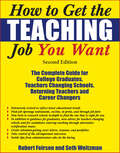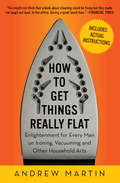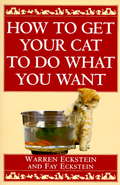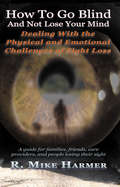- Table View
- List View
How to Flyfish: Tips, Lessons, and Techniques for Catching More Fish
by John SymondsNo matter if you’re a beginner or expert, there is always room to learnA licensed guide in the UK, John Symonds fishes with anglers of all talent levels, from rank beginners to experienced old-timers. He has seen the common mistakes that many fly fishers make and, over the years, has developed lessons that help anglers overcome their mistakes and really improve their fly-fishing prowess. In this book, Symonds teaches: Basic skills, from stringing your fly rod to tying on backing, fly line, leader, and tippet How to make casts for a variety of stream and lake conditions How to figure out what fish are feeding on, and then picking the proper imitation How to determine where fish are in lake or river Tips on using dry flies, nymphs, streamers, and caddis imitations And much, much more Symonds learned to fly fish through trial and error. As he did, he came to realize that finding good, basic information was difficult to come by. He fills that niche with this helpful little guidebook that is guaranteed to elevate your level of fishing.
How to Form a Nonprofit Corporation (7th edition)
by Anthony MancusoMancuso, an attorney and corporations expert, explains how to form and operate a tax-exempt corporation in every state, from completing an IRS tax-exemption application and preparing articles of incorporation to filling in minutes of the organizational meeting. The seventh edition is updated to provide the latest federal and state rules. It also provides the latest forms, including the new IRS form 1023. Articles, bylaws and minutes are included as tear-outs and on CD-ROM. Annotation ©2005 Book News, Inc., Portland, OR (booknews.com)
How to Form a Nonprofit Corporation in California
by Anthony MancusoStart a nonprofit corporation with the forms and information you need to give back to your community! Thousands of arts groups, educators, social service agencies and others have used How to Form a Nonprofit Corporation in California to get their organizations off the ground. With a nonprofit corporation, you'll gain recognition, save money, become eligible for grants, and protect your members and directors from liability. And you can do all of this without spending thousands on an attorney. With this easy to use guide, anyone can do it! How to Form a Nonprofit Corporation in California includes complete instructions for obtaining federal 501(c)(3) tax exemption and for qualifying public charity status forming a California nonprofit corporation, with the IRS. It also provides: . line by line instructions for completing your application . instructions and completed sample clauses for preparing articles of incorporation . ready to use bylaws for membership and non membership nonprofits . ready to use minutes for the organizational meeting . sheets with California's specific legal and tax requirements This edition is completely updated to cover changes to the law. You'll also get updated instructions for using Form 1023 and coverage of new online services and options related to forming your nonprofit corporation. Forms are available to download at nolo.com.
How to Form a Nonprofit Corporation in California
by Anthony MancusoForm a California nonprofit corporation Tens of thousands of arts groups, educators, social service agencies, environmental groups and others have used this bestselling book to form their California nonprofit. Your group can, too. Obtaining 501(c)(3) tax-exempt status has just become a lot easier with the new IRS Form 1023-EZ streamlined application. Use this book to form your California nonprofit corporation and obtain your federal and state tax exemptions. We provide step-by-step instructions for both the Form 1023 and the new easier Form 1023-EZ. How to Form a Nonprofit Corporation in California shows you how to: choose a corporate name and structure prepare and file nonprofit articles with the state of California qualify as a 501(c)(3) public charity obtain your federal and California tax exemptions create bylaws set up a corporate records book prepare minutes of your first board meeting and handle postincorporation filings and tasks. This new edition is completely updated to cover changes to the law.
How to Form a Nonprofit Corporation in California
by Anthony MancusoForm a California nonprofit corporation <P><P> Tens of thousands of arts groups, educators, social service agencies, environmental groups and others have used this bestselling book to form their California nonprofit. Your group can, too. <P><P> Obtaining 501(c)(3) tax-exempt status is a lot easier now with the IRS Form 1023-EZ streamlined application. Use this book to form your California nonprofit corporation and obtain your federal and state tax exemptions. We provide step-by-step instructions for both the longer IRS Form 1023 and the streamlined IRS Form 1023-EZ application. <P><P> How to Form a Nonprofit Corporation in California shows you how to: <br> choose a corporate name and structure <br> prepare and file articles of incorporation <br> qualify as a 501(c)(3) public charity <br> obtain federal and state tax-exempt status <br> create bylaws <br> set up a corporate records book <br> prepare minutes of your first board meeting and <br> handle post incorporation filings and tasks. <P><P> This new edition is completely updated to cover changes to the law.
How to Form a Nonprofit Corporation (National Edition): A Step-by-Step Guide to Forming a 501(c)(3) Nonprofit in Any State
by Anthony MancusoForm a 501(c)(3) tax-exempt nonprofit in your state The process of becoming a tax-exempt organization may appear intimidating, but with How to Form a Nonprofit Corporation, you can do it quickly, easily, and with confidence. You’ve got a cause you care about—now you just need the legal status that will help your organization raise money and work for that cause. Here, you’ll find all the forms and information you need to turn your group into a tax-exempt nonprofit. With How to Form a Nonprofit Corporation, you can form a nonprofit corporation in any state and gain 501(c)(3) tax-exempt status with the IRS. We provide step-by-step instructions for both IRS Form 1023 and the streamlined Form 1023-EZ federal tax-exemption application for smaller nonprofits. Learn how to: choose a legal name prepare articles of incorporation and bylaws for your nonprofit obtain federal and state tax-exempt status fill in minutes of the organizational meeting, and establish a corporate records book. This edition reflects the latest changes in the law, and includes contact information for finding updated state-specific instructions. It also provides information on B (benefit) corporations and other hybrid nonprofit entities that are allowed to both do good and make a profit.
How to Form a Nonprofit Corporation (National Edition): A Step-by-Step Guide to Forming a 501(c)(3) Nonprofit in Any State
by Anthony MancusoForm a 501(c)(3) tax-exempt nonprofit in your state You’ve got a cause you care about—now you just need the legal status that will help your organization raise money and work for that cause. Here, you’ll find all the forms and information you need to create a tax-exempt nonprofit for your group. Learn how to form a nonprofit corporation in any state and gain 501(c)(3) tax-exempt status with the IRS. We provide step-by-step instructions for both IRS Form 1023 and the streamlined Form 1023-EZ federal tax-exemption application. With this book you can: choose a legal name prepare articles of incorporation create your own bylaws obtain federal and state tax-exempt status prepare minutes for your organizational meeting, and establish a corporate records book. All forms are downloadable through a special link in the book.
How to Get a First: The Essential Guide to Academic Success
by Thomas DixonIn this informative guide, Thomas Dixon argues that you do not have to be a genius to get a first at university. He sets out to de-mystify first-class degrees in the arts, humanities and social sciences, clearly articulating the difference between the excellent and the merely competent in undergraduate work. This concise, no-nonsense guidebook will give prospective and current students advice on teaching and learning styles that prevail in university and on how to manage their two most important resources - their time and their lecturers. In an accessible and entertaining style, the author looks at subjects such as: making the transition from school to university developing transferable skills making use of lectures and seminars using libraries and the Internet note-taking, essays, seminars and presentations common mistakes to avoid writing with clarity and style revision and examinations. Illustrated with many examples from a range of academic disciplines, How to Get a First is an all-purpose guide to success in academic life. Visit the companion website www.getafirst.com
How to Get a Great Job: A Library How-To Handbook (American Library Association Series)
by Editors of the American Library AssociationIn our difficult time, or at any time, knowing how to find a great job is a necessary skill. All the resources you need for a successful job search are at your fingertips--and completely free--at your public library. It can be a daunting task, so here is expert advice on how to conduct proper research, build networks of friends and colleagues, put together a great resume, research industries that are constantly changing, prepare for an interview, negotiate a contract or a salary, and more. This could be the turbo-boost your job search needs.
How to Get a Green Card: Legal Ways To Stay In The U. S. A.
by Ilona BrayThe ultimate green card guide The U.S. immigration system is an enormous bureaucracy, so it’s vital that you understand it before attempting to apply for a green card. Making a mistake can lead to delays and hassles or even ruin your chances for success. How to Get a Green Card provides everything you need to know about qualifying for permanent U.S. residence if you don’t have an employer sponsoring you. Find out how to work with U.S. officials and prepare and present the right documents at the right time to get a green card through: parents, siblings, or adult children a U.S. spouse or fiancé green card lotteries (diversity visa) political asylum or refugee status a U visa for crime victims, or another category you might qualify for. The 14th edition covers new travel restrictions, public charge rules requiring more proof of income and health insurance coverage, changes to asylum eligibility, the wind-down of the Deferred Action for Childhood Arrivals (DACA) program, and other new restrictions and procedural changes. It also includes samples of all the key application forms.
How to Get a Green Card: Legal Ways To Stay In The U. S. A.
by Ilona Bray Loida Nicolas LewisImmigration is often in the news, but few people understand who is actually able to apply for a U.S. green card. Many who do apply are denied. This book offers a helpful, step-by-step guide to discovering whether you match one of the green card categories available for people with no U.S. job offers, such as through family relationships, asylum, the visa lottery, and more. The book takes readers through the entire application process, with the help of handy checklists of required forms and documents, tips for avoiding mistakes and dealing with legal complications and bureaucratic holdups, and sample forms. This edition is completely revised to reflect the latest laws, contact information, and fees, plus critical new procedural information based on recent actions by the Trump Administration. This book is not appropriate for people seeking temporary visas to the U.S. (such as tourist or student visas) or work-related green cards.
How to Get Grant Money in the Humanities and Social Sciences
by Raphael Brewster FolsomA valuable and engaging guide to applying for—and getting—grants in the humanities and social sciences Scholars in the humanities and social sciences need money to do research. This book shows them how to get it. In this accessible volume, Raphael Folsom shares proven strategies in a series of short, witty chapters. It features tips on how graduate students, postdocs, and young faculty members can present themselves and their work in the best possible light. The book covers the basics of the grant-writing process, including finding a mentor, organizing a writing workshop, conceptualizing the project on a larger scale, and tailoring an application for specific submissions. The book includes interviews with nine of the most respected scholars in the country, each of whom has evaluated thousands of grant applications. The first authoritative book on the subject, Folsom's indispensable work will become a must-have resource for years to come.
How to Get Into Law School
by Susan EstrichWhether you’re is a college junior facing the LSATs, a senior sitting with disappointing test scores, or someone who has always dreamed of a career in the law, there is too much at stake not to ask the hard questions about what lies ahead. How to Get into Law School will tell you all you need to know about: Choosing and applying to law school The law school admission test (LSAT) and law school applications Getting into law school Suceeding as a student Finding career fulfillment In How to Get Into Law School, Susan Estrich lends her unique point of view and far-ranging experience-as ace law student, tenured professor, renowned legal scholar and analyst-to the life and career questions applicants will face, and answers them in the frank, no-nonsense manner that is her trademark. Featuring anecdotes from admissions directors, professors, veteran attorneys, and adventurous students alike, How to Get Into Law School lays out the facts on: Applications Essays Getting Scholarships Community service The Rigors of Studying Surviving Interviews Finding Employment If you’re considering going to law school, this is your indispensable how-to guide. .
How to Get Into the Top Colleges, 3rd ed
by Krista Klein Richard MontaukThe ultimate guide for getting into the country's most elite colleges- with insider tips straight from admissions directors.Now fully revised, How to Get into the Top Colleges is the definitive resource for students determined to stand out in the crowd of applicants and join the ranks at the country's most prestigious schools. This book is an in-depth and targeted resource, which shows students just what it takes to make the grade at the nation's leading private and public colleges by taking them step by step through the entire application process. Includes exclusive, invaluable, and revealing interviews with the country's leading admissions directors.
How to Get Into the Top Law Schools, 4th edition
by Richard MontaukRichard Montauk, a savvy admissions insider, demystifies the application process and provides the tools to ace every step. Based on interviews with dozens of admissions officers, Montauk delivers a candid view of what leading law schools look for in an applicant. He also gives applicants solid advice on developing marketing strategies, writing winning essays, maximizing financial aid, and assessing and upgrading credentials to better match that ideal profile.
How to Get Into the Top MBA Programs, 5th Edition
by Richard MontaukSurefire Strategies for Getting Into the Top MBA ProgramsNow with new and expanded information on international MBA programs, comprehensive rankings of the leading schools, and new interviews with admissions officers, How to Get Into the Top MBA Programs provides a complete overview of what the top schools look for. This book features a step-by-step guide To The entire application process with in-depth advice from more than thirty admissions directors. it shows you how to:* Develop your optimal marketing strategy* Assess and upgrade your credentials* Choose the programs that are right for you* Write quality essays for maximum impact* Choose and manage your recommenders* Ace your interviewsPrepare for business school and get the most out of your program once you go.
How to Get into the Top MBA Programs, 6th Editon
by Richard Montauk J.D.Sure-Fire Strategies for Getting into the Top MBA Programs Fully revised for 2013-2014 Now with new information on online MBA programs, comprehensive rankings of the leading schools, and new interviews with admissions officers, How to Get Into the Top MBA Programs provides a complete overview of what the top schools look for. This book features a step-by-step guide to the entire application process with in-depth advice from more than thirty admissions directors. It shows you how to: * Develop your optimal marketing strategy * Assess and upgrade your credentials * Choose the programs that are right for you * Write quality essays for maximum impact * Choose and manage your recommenders * Ace your interviews * Prepare for business school and get the most out of your program once you go This fully revised Sixth edition also offers expanded coverage of Asian programs, North American accelerated programs, and the latest insights on the new GMATs and GREs, making it the most comprehensive, trusted MBA guide on the market.
How to Get Into Top Law Schools 5th Edition
by Richard MontaukThe most authoritative guide for law students-now revised and updated. Richard Montauk, an administrations insider and lawyer, demystifies the law school application process and provides the tools to ace every step along the way. Based on (and including) exclusive interviews with admissions officers, Montauk delivers a candid view of what leading law schools look for in an applicant. He also gives applicants solid advice on developing marketing strategies, writing winning essays, maximizing financial aid, and updating credentials to better match that ideal profile.
How to Get Money for College 2013: Financing Your Future Beyond Federal Aid
by Peterson'SHow to Get Money for College: Financing Your Future Beyond Federal Aid 2013 is a great resource for anyone looking to supplement his or her federal financial aid package with aid from colleges and universities. <P><P>This comprehensive directory points the reader to complete and accurate information on need-based and non-need gift aid, loans, work-study, athletic awards, and more. <P>This eBook offers profiles of more than 2,400 schools' financial aid awards, including types of aid, percentages of students applying for and receiving aid, and average aid packages; comprehensive overview of the financial aid process, common financial aid questions, samples of financial aid award letters, and how to file the FAFSA and CSS/Financial Aid PROFILE®.
How to Get Money for College 2014: Financing Your Future Beyond Federal Aid
by Peterson'SHow to Get Money for College: Financing Your Future Beyond Federal Aid 2014 is a great resource for anyone looking to supplement his or her federal financial aid package with aid from colleges and universities. <P><P>This comprehensive directory points the reader to complete and accurate information on need-based and non-need gift aid, loans, work-study, athletic awards, and more. <P>This eBook offers profiles of more than 2,400 schools' financial aid awards, including types of aid, percentages of students applying for and receiving aid, and average aid packages; comprehensive overview of the financial aid process, common financial aid questions, samples of financial aid award letters, and how to file the FAFSA and CSS/Financial Aid PROFILE®.
How to Get the Teaching Job You Want: The Complete Guide for College Graduates, Teachers Changing Schools, Returning Teachers and Career Changers
by Robert Feirsen Seth WeitzmanCompetition for the best teaching jobs is becoming more intense. Since publication of the first edition, when it was mainly the most desirable schools that were deluged by applications, the economic climate has made the teacher market more competitive across the board, and is changing hiring practices. Now extensively revised, this book maintains its place as the most up-to-date book available on job hunting for teachers. The authors cover changes in the educational marketplace; the new mandates about standardized testing and public reporting of student achievement–and what they mean for applicants; how new certification standards and schools’ requirements affect career changers; the growing acceptance of on-line applications and electronic portfolios; and provide additional advice for teachers applying to change schools or districts.This is also the only guide written by school administrators. Offering the insights and experience of two authors who do the hiring, it details a step-by-step program for taking charge of your teaching career. How to Get the Teaching Job You Want enables you to:* Match your unique talents to the needs of a particular school* Craft effective cover letters and resumes, using models that address the specific needs of college graduates, teachers changing schools, returning teachers and career changers* Make effective on-line applications* Leverage your achievements as an experienced teacher–or, for graduates or career changers, student teaching, substitute teaching, volunteer work or content knowledge–into a job offer* Locate jobs on-line and discover valuable information about schools, including test results, educational philosophy and names of key administrators* Design a portfolio in book or electronic format to showcase your abilities* Practice interview skills using 100 questions taken from real job interviews* Apply proven strategies for a variety of interview formats, including high stress interviews and performance interviews* Address controversial questions during interviewsThis book covers procedures for applying to elementary, middle and high schools; public, independent, and parochial schools; as well as international and boarding schools. Anecdotes recounting the experiences of real candidates looking for jobs illustrate key points. Access to the authors’ web site ensures that you will stay current in a changing job market. This is a vital book for teachers and aspiring teachers who want to achieve their career goals. It will also be invaluable for guidance counselors, psychologists, librarians and other school professionals.
How to Get Things Really Flat: Enlightenment for Every Man on Ironing, Vacuuming and Other Household Arts
by Andrew MartinIncludes actual instructions! “You might not think that a book about cleaning could be funny but this made me laugh out loud” (The Financial Times). For many reasons, men often neglect housekeeping chores—even when they share the house with other humans who wish they could get some help in that department. How to Get Things Really Flat combines witty observations, true tales of family life, useful information that takes the mystery out of such phenomena as dishwashers and vacuums, and answers to timeless questions including: During dusting, where does the dust go?What is the worst thing that can happen while ironing?Is housework therapeutic?How can I impress people with bicarbonate of soda?Aren’t men supposed to be dirty?And more! “A delightfully amusing tale about the joys and tribulations of doing housework that also serves as a very good primer on how to actually do housework . . . His main target audience is men. But women, I think, will also find Martin’s observations funny and many of his tips helpful . . . And if, after laughing your way through Martin’s text, you’re still not into doing housework, he has a tip for that, too: Hire a cleaner.” —Minneapolis Star-Tribune “Martin’s lighthearted but quite handy guide looks at the reasons why men don’t help out around the house as much as they ought to and proposes what can be done about that . . . After reading this offbeat and thoroughly delightful guide to housework, it’s hard to imagine anyone not wanting to give this stuff a try. Martin does what your mother never could: he makes doing chores seem fun, exciting, and rewarding.” —Booklist
How to Get Your Cat to Do What You Want
by Warren Eckstein Fay Eckstein"A practical, down-to-earth guide...Well organized and easy to read and to understand."CAT FANCYWorld-renowed pet behaviorist Warren Eckstein shows you how to walk with your cat, make it come when called, play for hours without ruining your plants and furniture, and more, in this warm, readable guide for feline lovers everywhere. Here are on-the-mark observations, wonderful insights, and step-by-step advice for: Alleviating kitty stress and nervousness; Coping with feline old age; Exercising your beloved mouser, and much more. Plus: diet, grooming, and dentistry tips.
How to Get Your Dog to Do What You Want: A Loving Approach to Unleashing Your Dog's Astonishing Potential
by Warren Eckstein Andrea EcksteinWhy settle for anything less than a best friend? Every dog wants to perform -- and deservedly gain your love and affection. With Warren Eckstein's expert guidance, you can forget about frustration and disobedience, and enjoy years with a loyal, alert, and very happy dog! Here are wonderful insights, witty observations, and step-by-step advice for:* Communicating with your dog* Hassle-free housebreaking*The training ABCs -- from sitting to heeling and beyond* Diet, grooming, exercise and dentistry tips* Coping with canine old age* And much, much more!"Too bad Warren isn't a marriage counselor! If only he could do for husbands what he does for dogs!" Kathie Lee GiffordFrom the Trade Paperback edition.
How To Go Blind and Not Lose Your Mind: Physical and Emotional Challenges of Sight Loss
by Mike HarmerHow To Go Blind And Not Lose Your Mind discusses the process of losing your sight and ways to deal with it. Written through the eyes of a person who has been through the process and survived. How To Go Blind And Not Lose Your Mind begins at the diagnosis, walks you through the stages of sight loss, and explores emotional and physical problems associated with going blind. It describes low vision, legal blindness, loss of independence, and what it may mean to you. You will find what help and visual aids are available. There are physical and emotional problems with loss of sight, however you can still keep your vision about living and enjoy a full, happy life. This book gives more than just hope, it is the vision you need while losing your sight.
